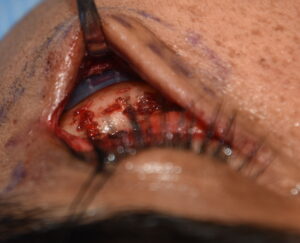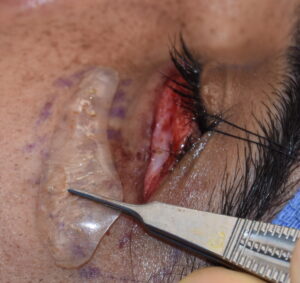Background: Like most facial structures the eyes must develop symmetrically both for functional and aesthetic reasons. Given the complexity of the anatomy that makes up the structures surrounding the eyeball, it is a marvel of embryology and developmental growth that the eye area develops as symmetric as it does most of the time.
Between the seven bones that make up the bony orbit and the upper and lower eyelids, there is ample opportunity for asymmetries to occur. Most eye asymmetries involve one structure such as the eyelids. But one unique type of eye asymmetry is vertical orbital dystopia. (VOD) It is unique because the entire orbital box of the eye is shifted downward, it not only lowers the eye but all the bones an soft tissues structures around it.
In assessing vertical orbital dystopia the usual patient concern is the position of the eyeball as that is what is the easiest to see. But more critical assessment will reveal that structure around the eye are also off, particularly the bony structures below the eye of the infraorbital rim and cheek. Less commonly these may be more important than the position of the eyeball itself.
Case Study: This male had a prior history of cheekbone reductions of which no notice was made before surgery of any differences in the shape of the eyes or the structures below it. After the cheek bone reductions and the resolution of the swelling, the difference in the left eye from that of the right and the deficiency below it became apparent. A review of the preoperative pictures revealed that it had been present before the cheekbone reductions. His interest was to secondarily address the deficient anterior cheek and infraorbital rim deficiency.


VOD can be very slight in magnitude and often not seen until there is a reason that it may become noticeable. (in this case the cheekbone reductions unveiled its presence) The 2mm lower eye position was not important to the patient but the flatter cheek and infraorbital rim was. Given the discreet bony deficiency a combination of standard implants was used for its correction.
Case Highlights:
1) Vertical orbital dystopia (VOD) affects the horizontal eye position as well as the inferolateral bony structures beneath it.
2) Mild or aesthetic VOD can be treated by bony augmentation of the deficient orbital rim and cheek.
3) In smaller bony VOD deficiencies a combination of standard implant materials can be used.
Dr. Barry Eppley
Indianapolis, Indiana




